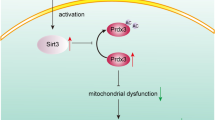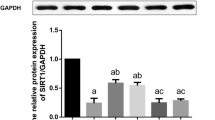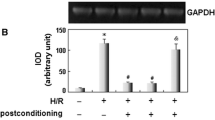Abstract
Myocardial ischemia/reperfusion (I/R) injury is a serious threat to the health of people around the world. Recent evidence has indicated that high-mobility group box-1 (HMGB1) is involved in I/R-induced inflammation, and inflammation can cause necroptosis of cells. Interestingly, dexmedetomidine (DEX) has anti-inflammatory properties. Therefore, we speculated that DEX preconditioning may suppress H/R-induced necroptosis by inhibiting expression of HMGB1 in cardiomyocytes. We found that hypoxia/reoxygenation (H/R) significantly increased cellular damage, as measured by cell viability (100 ± 3.26% vs. 53.33 ± 3.29, p < 0.01), CK-MB (1 vs. 3.25 ± 0.26, p < 0.01), cTnI (1 vs. 2.69 ± 0.31, p < 0.01), inflammation as indicated by TNF-α (1 ± 0.09 vs. 2.57 ± 0.12, p < 0.01), IL-1β (1 ± 0.33 vs. 3.87 ± 0.41, p < 0.01) and IL-6 (1 ± 0.36 vs. 3.60 ± 0.45, p < 0.01), and necroptosis, which were accompanied by significantly increased protein levels of HMGB1. These changes [cellular damage as measured by cell viability (53.33 ± 3.29% vs. 67.59 ± 2.69%, p < 0.01), CK-MB (3.25 ± 0.26 vs. 2.27 ± 0.22, p < 0.01), cTnI (2.69 ± 0.31 vs. 1.90 ± 0.25, p < 0.01), inflammation as indicated by TNF-α (2.57 ± 0.12 vs. 1.75 ± 0.15, p < 0.01), IL-1β (3.87 ± 0.41 vs. 2.09 ± 0.36, p < 0.01) and IL-6 (3.60 ± 0.45 vs. 2.21 ± 0.39, p < 0.01), and necroptosis proteins] were inhibited by DEX preconditioning. We also found that silencing expression of HMGB1 reinforced the protective effects of DEX preconditioning and overexpression of HMGB1 counteracted the protective effects of DEX preconditioning. Thus, we concluded that DEX preconditioning inhibits H/R-induced necroptosis by inhibiting expression of HMGB1 in cardiomyocytes.







Similar content being viewed by others
References
Koeppen M, Lee JW, Seo SW, Brodsky KS, Kreth S, Yang IV, et al. Hypoxia-inducible factor 2-alpha-dependent induction of amphiregulin dampens myocardial ischemia-reperfusion injury. Nat Commun. 2018;9:816.
Kawai H, Chaudhry F, Shekhar A, Petrov A, Nakahara T, Tanimoto T, Kim D, Chen J, Lebeche D, Blankenberg FG, et al. Molecular imaging of apoptosis in ischemia reperfusion injury with radiolabeled Duramycin targeting phosphatidylethanolamine: Effective Target Uptake and Reduced Nontarget Organ Radiation Burden. JACC Cardiovasc Imaging. 2018.
Ferrari RS, Andrade CF. Oxidative stress and lung ischemia-reperfusion injury. Oxidative Med Cell Longev. 2015;2015:590987.
Chorawala MR, Prakash P, Doddapattar P, Jain M, Dhanesha N, Chauhan AK. Deletion of extra domain a of fibronectin reduces acute myocardial ischaemia/reperfusion injury in hyperlipidaemic mice by limiting thrombo-inflammation. Thromb Haemost. 2018;118:1450–60.
Roberta A, Vicentino R, Carneiro VC, Carneiro VC, Allonso D, Guilherme R, et al. Emerging role of HMGB1 in the pathogenesis of schistosomiasis liver fibrosis. Front Immunol. 2018;9:1979.
Sekiguchi F, Domoto R, Nakashima K, Yamasoba D, Yamanishi H, Tsubota M, et al. Paclitaxel-induced HMGB1 release from macrophages and its implication for peripheral neuropathy in mice: evidence for a neuroimmune crosstalk. Neuropharmacology. 2018;141:201–13.
Loukili N, Rosenblatt-Velin N, Li J, Clerc S, Pacher P, Feihl F, et al. Peroxynitrite induces HMGB1 release by cardiac cells in vitro and HMGB1 upregulation in the infarcted myocardium in vivo. Cardiovasc Res. 2011;89:586–94.
Andrassy M, Volz HC, Igwe JC, Funke B, Eichberger SN, Kaya Z, et al. High-mobility group Box-1 in ischemia-reperfusion injury of the heart. Circulation. 2008;117:3216–26.
In EJ, Lee Y, Koppula S, Kim TY, Han JH, Lee KH, et al. Identification and characterization of NTB451 as a potential inhibitor of necroptosis. Molecules. 2018;23.
Xu Z, Jin Y, Yan H, Gao Z, Xu B, Yang B, et al. High-mobility group box 1 protein-mediated necroptosis contributes to dasatinib-induced cardiotoxicity. Toxicol Lett. 2018;296:39–47.
Galluzzi L, Kepp O, Chan FK, Kroemer G. Necroptosis: mechanisms and relevance to disease. Annu Rev Pathol. 2017;12:103–30.
Abdel-Ghaffar HS, Kamal SM, El Sherif FA, Mohamed SA. Comparison of nebulised dexmedetomidine, ketamine, or midazolam for premedication in preschool children undergoing bone marrow biopsy. Br J Anaesth. 2018;121:445–52.
Peng K, Qiu Y, Li J, Zhang ZC, Ji FH. Dexmedetomidine attenuates hypoxia/reoxygenation injury in primary neonatal rat cardiomyocytes. Exp Ther Med. 2017;14:689–95.
Zhang JJ, Peng K, Zhang J, Meng XW, Ji FH. Dexmedetomidine preconditioning may attenuate myocardial ischemia/reperfusion injury by down-regulating the HMGB1-TLR4-MyD88-NF-small ka, CyrillicB signaling pathway. PLoS One. 2017;12:e0172006.
Meng L, Li L, Lu S, Li K, Su Z, Wang Y, et al. The protective effect of dexmedetomidine on LPS-induced acute lung injury through the HMGB1-mediated TLR4/NF-kappaB and PI3K/Akt/mTOR pathways. Mol Immunol. 2018;94:7–17.
Deng F, Wang S, Cai S, Hu Z, Xu R, Wang J, et al. Inhibition of caveolae contributes to propofol preconditioning-suppressed microvesicles release and cell injury by hypoxia-reoxygenation. Oxidative Med Cell Longev. 2017;2017:3542149.
Deng F, Wang S, Zhang L, Xie X, Cai S, Li H, et al. Propofol through upregulating caveolin-3 attenuates post-hypoxic mitochondrial damage and cell death in H9C2 cardiomyocytes during hyperglycemia. Cell Physiol Biochem. 2017;44:279–92.
Muller T, Dewitz C, Schmitz J, Schroder AS, Brasen JH, Stockwell BR, et al. Necroptosis and ferroptosis are alternative cell death pathways that operate in acute kidney failure. Cell Mol Life Sci. 2017;74:3631–45.
McDonald KA, Huang H, Tohme S, Loughran P, Ferrero K, Billiar T, et al. Toll-like receptor 4 (TLR4) antagonist eritoran tetrasodium attenuates liver ischemia and reperfusion injury through inhibition of high-mobility group box protein B1 (HMGB1) signaling. Mol Med. 2015;20:639–48.
Mersmann J, Iskandar F, Latsch K, Habeck K, Sprunck V, Zimmermann R, et al. Attenuation of myocardial injury by HMGB1 blockade during ischemia/reperfusion is toll-like receptor 2-dependent. Mediat Inflamm. 2013;2013:174168.
Tong S, Zhang L, Joseph J, Jiang X. Celastrol pretreatment attenuates rat myocardial ischemia/ reperfusion injury by inhibiting high mobility group box 1 protein expression via the PI3K/Akt pathway. Biochem Biophys Res Commun. 2018;497:843–9.
Sun HJ, Lu Y, Wang HW, Zhang H, Wang SR, Xu WY, et al. Activation of endocannabinoid receptor 2 as a mechanism of propofol pretreatment-induced cardioprotection against ischemia-reperfusion injury in rats. Oxidative Med Cell Longev. 2017;2017:2186383.
Sun Y, Jiang C, Jiang J, Qiu L. Dexmedetomidine protects mice against myocardium ischaemic/reperfusion injury by activating an AMPK/PI3K/Akt/eNOS pathway. Clin Exp Pharmacol Physiol. 2017;44:946–53.
Chen Z, Ding T, Ma CG. Dexmedetomidine (DEX) protects against hepatic ischemia/reperfusion (I/R) injury by suppressing inflammation and oxidative stress in NLRC5 deficient mice. Biochem Biophys Res Commun. 2017;493:1143–50.
Nishida K, Otsu K. Autophagy during cardiac remodeling. J Mol Cell Cardiol. 2016;95:11–8.
Frank D, Vince JE. Pyroptosis versus necroptosis: similarities, differences, and crosstalk. Cell Death Differ. 2018.
Acknowledgments
We thank M. Arico from Liwen Bianji, Edanz Group China (www.liwenbianji.cn/ac), for editing the English text of a draft of this manuscript.
Funding
This study was supported by Taihe Hospital Science and Technology Project in 2018 to Dr. Chen, Jingyi (grant numbers: 2018JJXM046).
Author information
Authors and Affiliations
Contributions
Jingyi Chen conceived and designed the project. Jingyi Chen performed the experiments with the help of Zhenzhen Jiang, Xing Zhou, Xingxing Sun, Jianwei Cao, Yongpan Liu, and Xianyu Wang. Jingyi Chen wrote the manuscript. All authors discussed the manuscript.
Corresponding author
Ethics declarations
Conflict of Interest
The authors declare that they have no conflict of interests.
Ethical Approval
This article does not contain any studies with human participants or animals performed by any of the authors.
Informed Consent
This article does not contain any studies with human participants performed by any of the authors.
Additional information
Publisher’s Note
Springer Nature remains neutral with regard to jurisdictional claims in published maps and institutional affiliations.
Rights and permissions
About this article
Cite this article
Chen, J., Jiang, Z., Zhou, X. et al. Dexmedetomidine Preconditioning Protects Cardiomyocytes Against Hypoxia/Reoxygenation-Induced Necroptosis by Inhibiting HMGB1-Mediated Inflammation. Cardiovasc Drugs Ther 33, 45–54 (2019). https://doi.org/10.1007/s10557-019-06857-1
Published:
Issue Date:
DOI: https://doi.org/10.1007/s10557-019-06857-1




